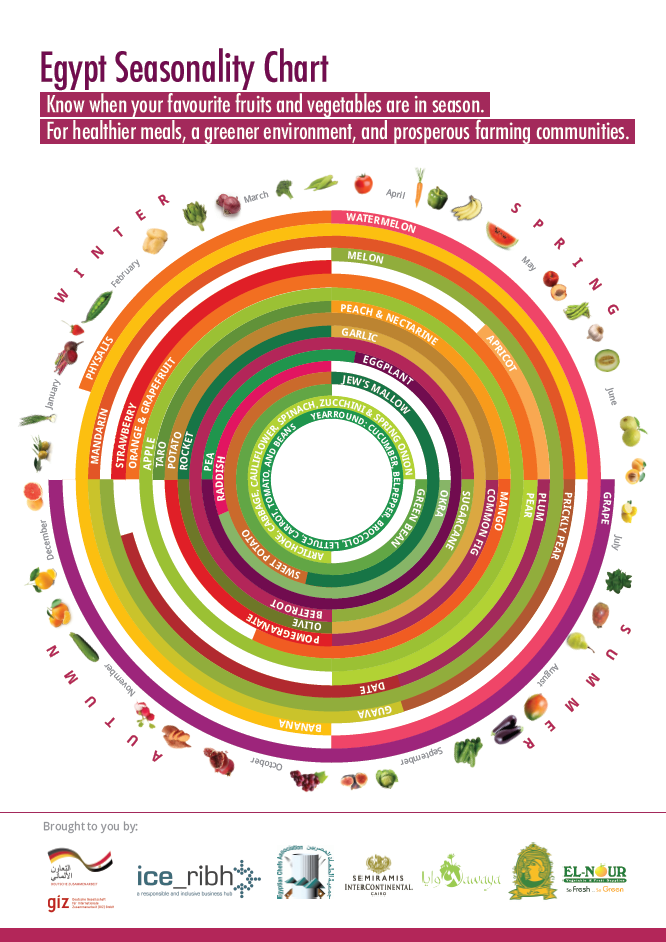Egyptian produce
Vegetables
Egyptian vegetables are second to none: Egypt has sunshine and plenty of water all year round, and a varied climate from Alexandria in the north to Abu Simbel in the south. They are delivered fresh daily to the soo' سوق (market) or the Kudari خـُد َري(greengrocer).
The staples are baTaaTis بـَطا َطـِس (potatoes), TamaaTim طـَما َطـِم (tomoatoes) baSal بـَصـَل. It is possible to grow potatoes all year round in Egypt, so they are always new potatoes. Tiny potatoes are very expensive in Europe, but in Egypt they are regarded as too fiddly: most greengrocers keep a box of them under the counter: widows buy them for a ginyh a kilo. Tomatoes are usually picked when they are ripe, so they are deep red and sweet. They are great to eat or to cook with, but they don't last long, even in the fridge. You can get red or white onions: most people prefer red. You can buy onions from the greengrocer, or from a truck that drives round residential areas, advertising his wares through a tannoy.
Other common vegetables are kurunb كـُر ُنب (cabbage), koosa كوسـَة (courgettes), which are whiter and firmer than the European version, bitingaen بـِتـِنجا َن (aubergines)- large purple ones and long thin ones in white or purple, and gazaar جـَزا َر (carrots).
In season, you will find bammya بـَمّيـَة (okra), fasoolya فـَسوليـَة (french beans), 'arnabeeT قـَرنـَبيط (cauliflower) and burookooli بـُروكولي (broccoli).
The greengrocer will usually have a small selection of fresh herbs, tied up in small bunches using grass or reed strips, covered with a damp sack to keep it fresh. Even poor people buy two or three bunches at a time: so the greengrocer thinks that Europeans are very strange when they ask for just one bunch.
You will usually find kuzbara كـُذبـَر َة (coriander), ba'doonis با َقدونـِس (parsley) and gargeer جـَرجير (rocket). Egyptian rocket has much bigger leaves than the European version. Also available are niAnaeA نـِعنا َع (mint) andshabat شـَبـَت (dill). karafs كـَر َفس is treated as a herb: it is not blanched, and you use everything, including the leaves. baSal 'aKdar بـَصـَل أخد َر (spring onions) ar available most of the year. You can get rihaen ر ِحا َن in supermarkets, but the greengrocer does not sell it because most people grow it outside their house or on the balcony. The greengrocer always has little net bags of chinese-produced thoom ثوم (thwm): occasionaly he will have bunches of locally grown garlic.
This chart shows when each type of vegetable is in season.

Fruit
Meat
The same can not be said for Egyptian meat. While it is always fresh, butchery techniques in Egypt are somewhat unsophisticated and make European butchery look more like an anatomical dissection.The gazzaar جـَزّا َر (butcher) simply hangs a carcass above the pavement and crudely hacks off pieces as required.
firaeK فـِرا َخ (chicken) and lahma kandooz لـَحمـَة كـَندوز (beef) are the main meats: 'arnab أرنـَب (rabbit) and hamaem حـَما َم (pigeon) are also available. During Aeed عيد, families buy and kill a whole animal- goat is common, and very big families get a cow or a camel.
The main cuts of meat are mafrooma مـَفرومـَة (minced) mukaAbaet مـُكـَعبا َت (cubes), kufta كـُفتـَة (rolls of minced meat with spices) and sugoog سـُجوج (sausages). Note: find out what else they do in Metro. kibda كـِبد َة (liver) is very popular, and is often more expensive than steak, and other offal is also available, for example kilya كـِليـَة (kidney), 'alba قـَلبـَة (heart) and 'unthyaan أ ُنثيا َن (testicles).
Mike Green 28Nov2015


